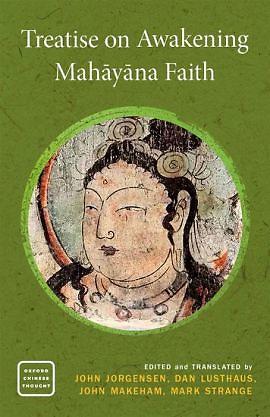Edited and translated by John Jorgensen, Dan Lusthaus, John Makeham, and Mark Strange

Treatise on Awakening Mahayana Faith
Dasheng qixin lun, or Treatise on Awakening Mahāyāna Faith has been one of the most important texts of East Asian Buddhism since it first appeared in sixth-century China. It outlines the initial steps a Mahāyāna Buddhist needs to take to reach enlightenment, beginning with the conviction that the Mahāyāna path is correct and worth pursuing. The Treatise addresses many of the doctrines central to various Buddhist teachings in China between the fifth and seventh centuries, attempting to reconcile seemingly contradictory ideas in Buddhist texts introduced from India. It provided a model for later schools to harmonize teachings and sustain the idea that, despite different approaches, there was only one doctrine, or Dharma. It profoundly shaped the doctrines and practices of the major schools of Chinese Buddhism: Chan, Tiantai, Huayan, and to a lesser extent Pure Land. It quickly became a shared resource for East Asian philosophers and students of Buddhist thought.
Research
Trained in archaeology and art history, I seek to support my research into early Chinese literature with relevant knowledge of Chinese material culture. I also have a keen interest in questions of intellectual history, which I approach from the angle of textual interpretation. My study of the early history of commentary on the anthology Songs of Chu 楚辭 led me to examine the Chinese commentarial tradition more broadly. This has stimulated my further engagement with certain Chinese conceptual ideas related to social relationships and the possibilities of their meaningful representation in English.
Recently, I have also begun to explore the possibilities of employing algorithms to examine multi-layered texts that consist of a main text with a range of different commentaries. My aim here is to understand better the impact that traditional interpretation of canonical or otherwise relevant texts might have on modern and contemporary research of such sources.
Selected Publications
- “Scholars’ Backgrounds and Their Impact on Reading Newly Discovered Texts: Approaches to Zhongxin zhi dao (忠心之道)” in Shirley Chan (ed.). Reading Through Recovered Ancient Chinese Manuscripts. Sydney: Sydney University Press, 2020.
- “Antlers? Or Horns? Towards Understanding Gan Bao 干寶, the Historian” in China in the World – The World in China – A Transcultural Perspective, 4 Vol., Natascha & Joachim Gentz, Barbara Mittler, Catherine Vance Yeh (eds.). Großheirath: Ostasien Verlag, 2019.
- “How to Achieve Good Governance – Arguments in Tang Yu zhi dao 唐虞之道 (The Ways of Yao and Shun) and Zhong Xin zhi dao 忠信之道 (The Ways of Uprightness and Reliability) “ in Dao Companion to the Guodian Bamboo Manuscripts. Shirley Chan, Daniel Lee (eds.). New York: Springer, 2019.
- “Immunity to Temptation – ‘Power’ in Chinese Language.” In Power: China Story Yearbook 2018, Jane Golley, Linda Jaivin, Paul Farrelly (eds.). Canberra: Australian National University Press, 2019.
- 回潮的技巧—更新的技巧:王逸与被认定已失传的刘安的《离骚传》 (The Skill of Reverting – the Skill of Renewal: Wang Yi and the supposedly lost Tradition of the Lisao by Liu An),“ Zhongguo xueshu 中国学术 (China Scholarship) Vol. 7.1:133-157 (2009).
- “The Quest for a Classic: Wang Yi and the Exegetical Prehistory of his Commentary to the Lisao,” Early China 29: 109-160 (2004)
Research
Much of my research centres on the eleventh century AD. A long-running interest has been the life and work of the historian and statesman Sima Guang 司馬光 (1019-1086), especially his magisterial chronicle, Zi zhi tong jian 資治通鑑. I am engaged with reconstructing how Zi zhi tong jian contributed to debates of Sima Guang’s time, when the authority of historical knowledge in shaping present policy came under intense scrutiny. I am working on two selected translations of Zi zhi tong jian as well as on a multi-volume study of its historiography and political thought.
I also study the historical and political thought of the third to the sixth centuries. One of my particular interests in this period is how Sinitic Buddhist thought was used as a resource in the intellectual and political discourses of the time. Emperor Wu of Liang 梁武帝 (r. 502-548) has recurrently drawn my notice for his radical attempts to use Buddhist thought as justification for political action. He is the focus of an on-going series of studies.
Selected Publications
- Treatise on Awakening Mahāyāna Faith, tr. with John Jorgensen, Dan Lusthaus, and John Makeham, New York: Oxford University Press, 2019.
- ‘When Emperor Wu met Bodhidharma: a reading of mid-Tang religious policy’, Asia Major 31.1, 2018: 116-165.
- ‘Sima Guang,’ in Berkshire Dictionary of Chinese Biography, Kerry Brown, ed., Great Barrington, MA: Berkshire Publishing, 2014, vol. 2, pp. 664-683.
- ‘Representations of Liang Emperor Wu as a Buddhist Ruler in Sixth- and Seventh-century Texts,’ Asia Major 24.2, 2011: 53-112.
- ‘An Eleventh-Century View of Chinese Ethnic Policy: Sima Guang on the Fall of Western Jin,’ Historical Sociology 20.3, 2007: 235-58.
- ‘A Reading of Hou Jing’s Rebellion in Zizhi tongjian (Comprehensive Mirror to Aid Government): The Construction of Sima Guang’s Imperial Vision,’ in Reading China: Fiction, History and the Dynamics of Discourse, Daria Berg, ed., Leiden: E.J.Brill, 2006, pp.200-37.
